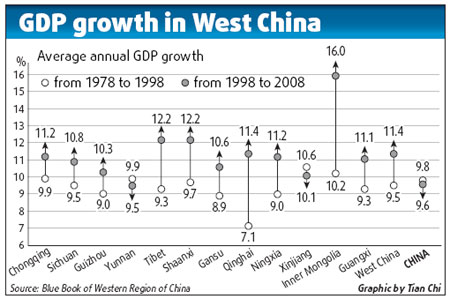
|
BIZCHINA> Top Biz News
 |
|
West China still struggling
By Tan Yingzi (China Daily)
Updated: 2009-07-14 07:42
Despite massive exploitation of its natural resources and efforts made via the Go West Campaign, the economy of West China still lags behind the rest of the nation, experts said as the latest Blue Book of the Western Region of China was released. The book, a report on economic development in the western region, has been published annually since 2005. It reveals that while the area has seen a spike in projects that tap into its hydroelectric and metal ore potential, it has not yet closed the gap on wealthier provinces and remains the poorest region. "The reform of our financial system is the best way to bridge the widening gap between the western and eastern parts of the country," said Yao Yang, deputy director of the China Center for Economic Research at Peking University.  Yao said additional regional banks and a local capital market would encourage more investment in the region. Cai Jimin, deputy director of the Institute for Economic Research at Tsinghua University, said the exploitation of West China's rich natural resources has not translated into a financial windfall "because of the unreasonable tax system of natural resources and low compensation standards".
In recent years, West China has experienced its fastest period of economic growth since the founding of the People's Republic in 1949. The region is enjoying an average annual GDP increase of 11.42 percent, which is higher than the country's average of 9.64 percent. In 1999, West China's GDP increase was just 7.2 percent. And West China's average GDP per capita has doubled in recent years from 4,122 yuan ($600) to 13,186 yuan ($1,933). The average disposable income per capita has also increased, from nearly 6,000 yuan in 1999 to 11,309 yuan in 2007, the report says. But the region's GDP was only 17.8 percent of China's total in 2008 and its average GDP per capita was only 41.09 percent of that in the east. People in West China, despite the improvements, are earning less than the country's average. Eight western provinces were among the 10 lowest income areas in 2007. Gansu province had the lowest average income - people there earned 42.34 percent of the average income in Shanghai. The Blue Book was compiled by the Centre for Studies of China Western Economic Development at Northwest University in Xi'an, Shaanxi province. China initiated its western development strategy in 1999 to boost the underdeveloped area, which includes 12 provinces, autonomous regions and Chongqing municipality.
Policies such as heavy government investment, preferential tax rates and flexibility have been implemented to boost local infrastructure and environment. In the past decade, nearly 1.74 trillion yuan has been poured into 102 major projects. The annual growth rate in investment in fixed assets is more than 20 percent. But it lags behind, in part, because of historic underdevelopment, the report says. Further advances are planned for the next 10 years, said Li Yingming, deputy director of the Department of Western Region Revitalization under the National Development and Reform Commission. Three regional economic zones, the Guanzhong-Tianshui, Beibu Gulf and Chengdu-Chongqing zones, will spearhead its development, Li said. (For more biz stories, please visit Industries)
|